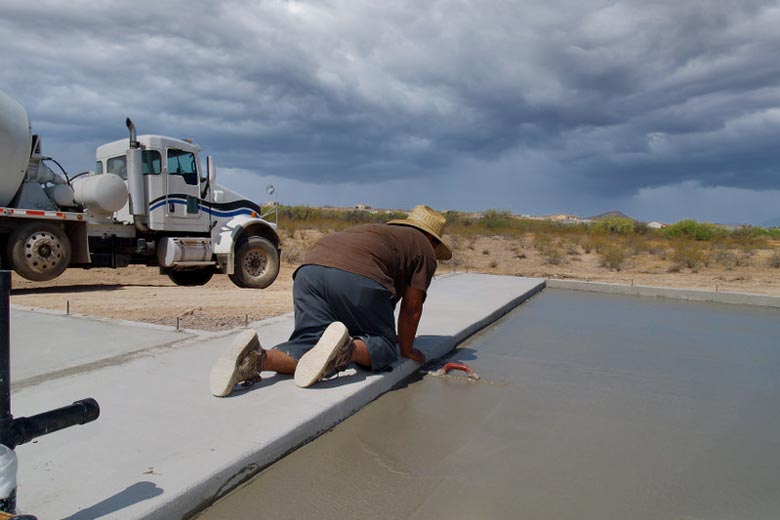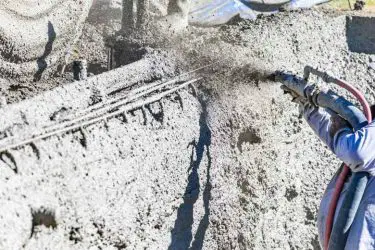Concrete is one of the most popular building materials for many different reasons: it’s cheap, versatile, and relatively easy to work with. However, when the rain comes in contact with newly poured concrete, it can negatively affect the surface and cause structural issues in the future. So, how long after pouring is concrete safe from the rain?
Concrete is safe from the rain 5 to 8 hours after it has been poured. However, weather conditions before the rain may shorten or extend this timeframe. For example, the concrete may cure faster in warm weather but take longer in cold or damp weather.
The rest of this article will explain how rain damages uncured concrete and what you can do to protect new concrete from rain damage. Read on for in-depth information on these and answers to other questions you may have about protecting concrete from rain.

Table of Contents
How Long Do I Need To Protect Concrete From Rain?
Like any building material, concrete needs time to cure before being used or exposed to the elements. Most notably, curing is a crucial step in protecting concrete from rain damage. Without curing, the surface of newly poured concrete is susceptible to damage that can be expensive and time-consuming to repair.
You need to protect concrete from the rain for at least 5-8 hours, as a rule of thumb. If you don’t wait long enough, the concrete could start cracking and crumbling. And if it rains while concrete is still wet, that could cause even more damage.
After this time, leave the concrete on its own to cure for around 28 days before walking on it or exposing it to heavy stress. This waiting period, often called the “curing time,” is crucial because it allows concrete to dry out more fully, preventing cracks from forming. It’s also during this time that water can cause mold to grow on the surface of the concrete.
To protect new concrete before it dries, particularly when concerned about rain damage, throw some plastic sheeting over the slab once it’s poured. This simple method effectively protects fresh concrete from rain damage for 5-8 hours—the length of time experts recommend as a standard delay period.
What Happens if It Rains on Uncured Concrete?
Concrete is a mix of cement, water, and aggregate. When the water in the mixture starts to evaporate, the cement begins to harden (cure).
If it rains on uncured concrete, the added moisture will cause it to swell and crack. The rain may also wash away the finer cement particles and form pits or holes in the surface of the concrete. Consequently, the concrete weakens, compromising its structural integrity.
Signs of rain damage include:
- Cracks on the surface of the concrete
- A change in color or glossiness on the surface of the slab
- Pits or holes on the concrete
- A spongy feeling when walking on the concrete
If you see any of these signs, the concrete may have begun to take damage from the rain. Luckily, it can typically recover from mild forms of rain damage if treated properly.
How To Protect Concrete From Rain Damage
As mentioned, concrete needs to cure for at least 5-8 hours before it’s safe from the rain. If pressed for time, however, some workarounds allow for building on the slab in less than one day.
Here are 3 easy ways to protect concrete from rain damage:
- Cover the concrete with plastic sheeting. For this quick fix, try the Xpose Safety Clear Poly Sheeting (available on Amazon.com). It’s designed for industrial applications, made to withstand rain, storm, and snow impact.
- Build a temporary roof and walls around the slab. Indeed, this requires more prep work and materials than the quick fix above, but it’s more effective. Temporary shelters are also good to use when adding a complex finishing element, like colored or stamped concrete, to avoid taking any chances with the rain interfering.
- Postpone construction until the rain subsides.
Read more: Do Concrete Workers Work in the Rain?
How To Repair Concrete With Rain Damage
Even despite best efforts, concrete may incur slight damage by rain, but it’s possible to get it back into working order with a little bit of TLC.
Here’s how to repair concrete damaged by rain:
1. Assess the Damage
Inspect the surface of the concrete. If many cracks or holes are discovered, it’s best to hire a professional to examine the extent of the damage and recommend the most effective ways to solve the problem. If the damage is minimal, continue to the next step.
2. Clear Away the Debris
Ensure the surface is as clean as possible before attempting any repairs. Sweep away any debris settled into the slab, and use a pressure washer on the lowest setting to blast off the top layer of dirt. Avoid using a high-powered rush of water, as this can wash away some of the cement particles.
3. Apply Self-Leveling Compound
Once dirt and other grime is clear, apply a self-leveling compound onto any holes or cracks. A self-leveling compound is a type of thin concrete repair material that contains Portland cement and mineral aggregates. It’s easy to use, spreads easily, and dries quickly.
4. Let the Slab Cure for 48 Hours
Finally, it’s necessary to let the self-leveling compound cure for at least 48 hours. Remember, a finishing material can’t be applied over a repairing compound until it’s dried completely.
Also, avoid walking on the concrete while it’s curing. The added weight may push the self-leveling compound out of the cracks, either rendering it useless or making the damage worse.
To get a better idea of what this looks like, here’s an informative YouTube video describing how to save new concrete from rain damage:
Factors Affecting Concrete Dry Time
The curing time of concrete depends on the following factors:
- The weather conditions (temperature and humidity)
- The water-cement ratio and aggregate size
- The type of cement used
The Weather Conditions (Temperature and Humidity)
When constructing concrete on a hot, sunny day with low humidity, the slab will dry out quickly. This is why it’s best to schedule construction when such conditions are expected, whenever possible.
Keep in mind, however, since rainy days are often humid, they increase cement’s hydration rate—the absorption of water by chemicals in concrete. Ultimately, this can prolong the drying process. If it rains while concrete is curing, it’s necessary to protect the concrete against further damage. Notably, the best way to do this is to check weather forecasts before pouring the slab and plan accordingly.
The Water-Cement Ratio and Aggregate Size
When using a higher water to cement ratio, concrete takes longer to dry. Additionally, the smaller the aggregate size, the more time it takes to cure.
However, small aggregate is usually an indicator of stronger concrete due to its dense composition. This can be useful in some cases where strength is needed, but it also means waiting longer before walking on the slab.
The Type of Cement Used
The curing time of the concrete depends on the type of cement used. For example, traditional Portland cement takes a long time to cure compared to other types such as the rapid hardening cement.
Rapid hardening cement is excellent when in a hurry to pour concrete. Although it’s more expensive than regular Portland cement, it’s usually worth the cost when on a tight schedule.
Bottom Line
It takes 5-8 hours for new concrete to be safe from rain. However, if concrete is unprotected during this period, rainwater can destroy and wash out some of the cement particles in the slab. This ruins the slab’s strength, much like when rain washes away dirt from a paved road.
To protect concrete against water damage, place a protective covering over the slab during its curing period. This helps prevent it from getting washed away by the rain.



